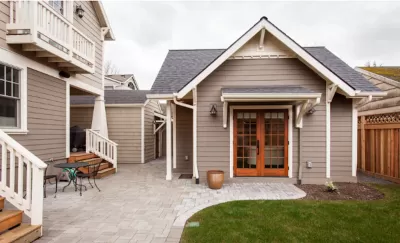A provision in the city’s ADU ordinance allows developers to build an essentially unlimited number of units on single-family lots.

Developers in San Diego are using the city’s ADU Bonus Program to build multi-unit accessory dwelling units (ADUs) that go far beyond the typical ‘granny flat,’ reports Ben Christopher in CALmatters. “The city’s one-of-a-kind ordinance offers landlords a one-for-one deal. If they agree to construct an ADU and keep the rent low enough for San Diegans making under a certain income, they’re automatically permitted to build a second ‘bonus’ unit, which they can rent at whatever price they like.”
The law generally allows for up to five units on one property. “But in bus-and train-adjacent ‘transit priority’ areas — a designation that covers much of San Diego’s urban core — a landlord can alternate affordable and bonus units again and again and again.” Although there are height and floor area ratio limits, “you can squeeze in an awful lot of ADUs within those parameters.” In one case, a single lot now holds nine apartment units, of which four are ADUs. According to the city, a typical ADU application includes 4 to 7 units, while the largest project with a submitted application is 148 units.
As Christopher explains, “Depending on your perspective, San Diego’s ‘crafty little maneuver’ is either an ingeniously clever use of state law to provide a much needed boost to the local housing supply or a sneak effort to foist an intolerable degree of construction and density upon unsuspecting residents while only providing a token degree of affordability.”
FULL STORY: Not your grandma’s granny flat: How San Diego hacked state housing law to build ADU ‘apartment buildings’

Planetizen Federal Action Tracker
A weekly monitor of how Trump’s orders and actions are impacting planners and planning in America.

Map: Where Senate Republicans Want to Sell Your Public Lands
For public land advocates, the Senate Republicans’ proposal to sell millions of acres of public land in the West is “the biggest fight of their careers.”

Restaurant Patios Were a Pandemic Win — Why Were They so Hard to Keep?
Social distancing requirements and changes in travel patterns prompted cities to pilot new uses for street and sidewalk space. Then it got complicated.

Platform Pilsner: Vancouver Transit Agency Releases... a Beer?
TransLink will receive a portion of every sale of the four-pack.

Toronto Weighs Cheaper Transit, Parking Hikes for Major Events
Special event rates would take effect during large festivals, sports games and concerts to ‘discourage driving, manage congestion and free up space for transit.”

Berlin to Consider Car-Free Zone Larger Than Manhattan
The area bound by the 22-mile Ringbahn would still allow 12 uses of a private automobile per year per person, and several other exemptions.
Urban Design for Planners 1: Software Tools
This six-course series explores essential urban design concepts using open source software and equips planners with the tools they need to participate fully in the urban design process.
Planning for Universal Design
Learn the tools for implementing Universal Design in planning regulations.
Heyer Gruel & Associates PA
JM Goldson LLC
Custer County Colorado
City of Camden Redevelopment Agency
City of Astoria
Transportation Research & Education Center (TREC) at Portland State University
Camden Redevelopment Agency
City of Claremont
Municipality of Princeton (NJ)





























